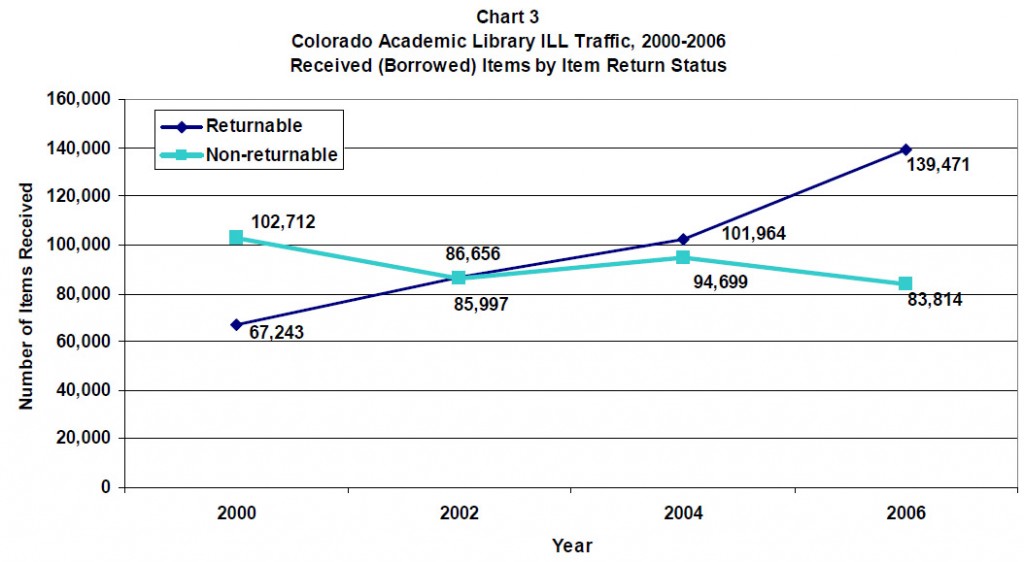Interlibrary loan (ILL) in Colorado academic libraries is headed in 2 different directions, per figures reported by the National Center for Education Statistics (NCES).[note]NCES Academic Library Surveys for 2000, 2002, 2004, and 2006. The Academic Library Survey (ALS) is conducted by the NCES biennially. Data is collected regarding library services, collections, library staff, expenditures, electronic services, and information literacy. See http://nces.ed.gov/pubsearch/getpubcats.asp?sid=041#.[/note] Two types of items are involved in ILL: returnable items and non-returnable items.
Returnable items are materials the lending library expects to be returned, such as books, sound recordings, audiovisual materials, and microfilm reels. Non-returnable items are materials that do not need to be returned, such as photocopies, print copies from microfilm, electronic and full-text documents.[note]NCES E.D. Tab Academic Libraries: 2000. See http://nces.ed.gov/pubs2004/2004317.pdf.[/note]
Comparing National and Colorado Interlibrary Loan Data
- Trends identified in Colorado are also occurring nationally, although not to the same extent in most areas
- Nationally, non-returnable items loaned decreased by 5.3 percent (more than 3 times Colorado’s decrease)
- Returnable items loaned increased by 34.0 percent nationally, which is just over half that of Colorado’s growth of 64.7 percent
- Non-returnable items borrowed nationally decreased by 1.6 percent, much less than Colorado’s decrease of 18.4 percent
- Returnable items borrowed nationally increased by a notable 40.8 percent, but Colorado’s increase of 107.4 percent is substantially larger
Colorado’s academic libraries experienced an interesting combination of changes in interlibrary loan traffic between 2000 and 2006. A large increase in interlibrary loans for returnable items occurred, while interlibrary loans for non-returnable items decreased (see Chart 1).
- ILL for returnable items increased 83.0 percent, from 156,842 to 287,000
- ILL for non-returnable items decreased 10.7 percent, from 188,896 to 168,693
Interlibrary loan can be further divided into items provided and items received. Provided items are materials loaned by the academic library via ILL and received items are materials borrowed by the academic library via ILL.
Items Provided (Loaned)
Between 2000 and 2006, items provided by Colorado’s academic libraries had a slight decrease for non-returnable items and a significant increase in returnable items (see Chart 2).
- ILL for non-returnable items provided decreased from 86,184 to 84,879, a drop of 1.5 percent
- ILL for returnable items provided rose from 89,599 to 147,529, an increase of 64.7 percent
Items Received (Borrowed)
A larger change was seen among items received by Colorado’s academic libraries between 2000 and 2006. The decrease was sharper for non-returnable items received than that of items provided and the number of returnable items received more than doubled between 2000 and 2006 (see Chart 3).
- ILL for non-returnable items received decreased from 102,712 to 83,814, a drop of 18.4 percent
- ILL for returnable items received rose from 67,243 to 139,471, an increase of 107.4 percent
Why the ups and downs?
A likely reason for the decrease in non-returnable ILL requests is the increasing availability of electronic full-text databases offered by academic libraries. The ease, convenience, and immediacy of downloading a full-text article when needed could decrease the need for copied articles to be sent from one library to another.
Anne K. Beaubien, in her ARL White Paper (2007), suggests that ILL requests have increased in the past few years because there has been “an increase in discovery tools, such as indices, search the Web, and Google Books that [have] augmented people’s awareness of publications.”[note]Beaubien, Anne K. (2007). ARL White Paper on Interlibrary Loan. Retrieved August 28, 2008, from http://www.arl.org/bm~doc/ARL_white_paper_ILL_june07.pdf. [/note] With the increased knowledge of what is available, it is possible that students, faculty, and staff are increasingly utilizing ILL at academic libraries.
The larger increase in Colorado’s ILL, as compared to the national increase, could be related to Prospector, a service provided by the Colorado Alliance of Research Libraries. Prospector is the unified catalog of 23 academic, public, and special libraries in Colorado and Wyoming.[note]About the Prospector Colorado Unified Catalog. Retrieved November 4, 2008, from http://prospector.coalliance.org/screens/about_prospector.html.[/note] Fifteen of the 23 participating libraries are academic libraries. The accessibility of searching the catalogs of 23 libraries across the state could account for Colorado’s larger increase in ILL for returnable items.
Rose Nelson, Systems Librarian for the Colorado Alliance of Research Libraries, said, “I think one of the benefits of having a union catalog where most of the libraries run the same ILS, such as in the case of our INN-Reach system, is that patron placed holds are a seamless process; which in turn, increases ILL usage.”
She also attributes the increase in ILL usage to the statewide courier service. “[T]his coupled with Prospector is much of the reason ILL usage is so high in Colorado.”[note]Email communication with Rose Nelson of the Colorado Alliance of Research Libraries, November 13, 2008.[/note]
Conclusion
It is known that Colorado’s ILL usage for non-returnable items is going down and ILL usage for returnable items is clearly going up. However, it is not known for sure what is causing these trends in ILL in Colorado. Increased full-text options, Prospector, and the statewide courier service are all strong possibilities.


